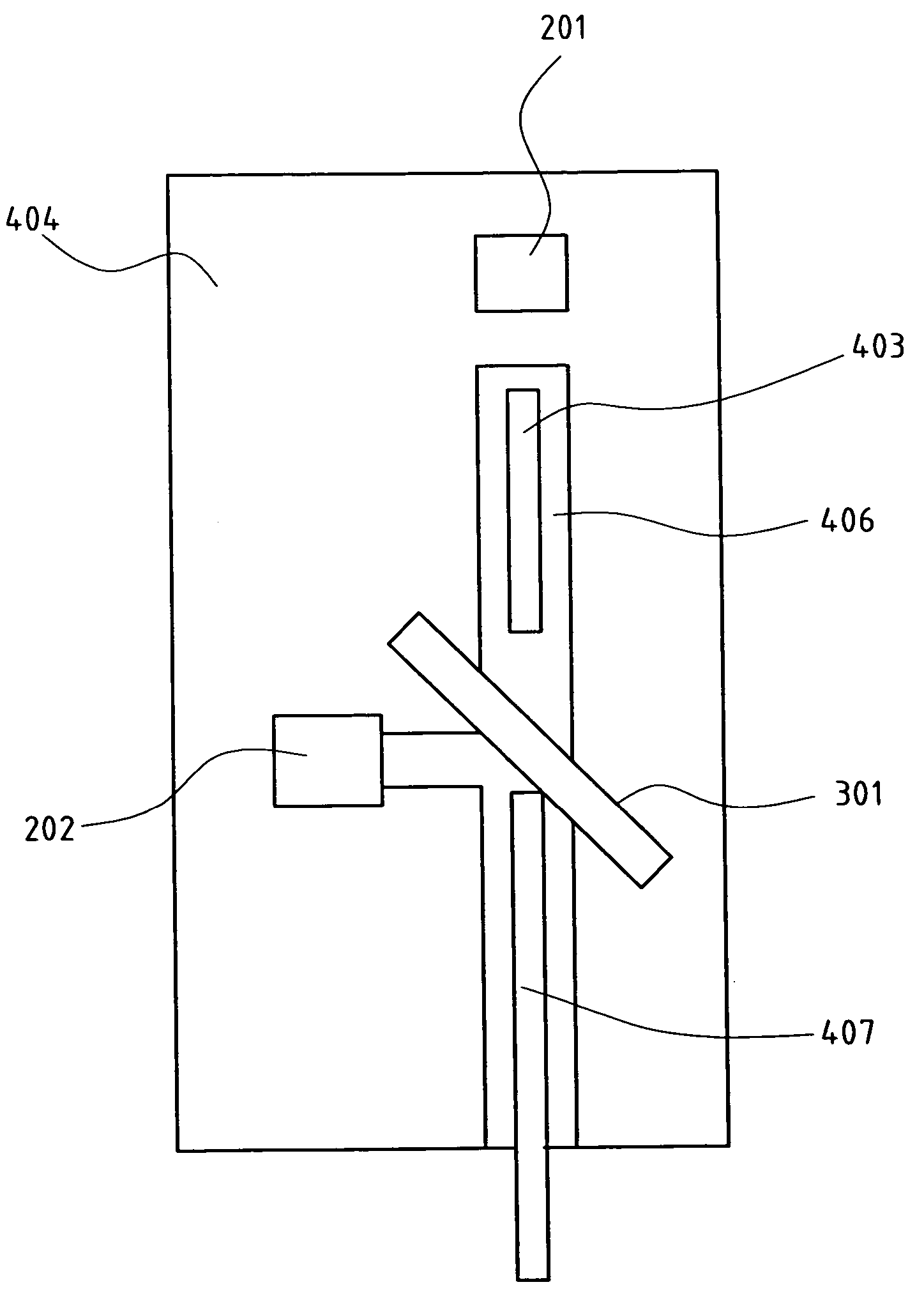Bi-directional transceiver module based on silicon optic bench
a transceiver module and optical bench technology, applied in the direction of optics, optical waveguide light guides, instruments, etc., can solve the problems of low external quantum efficiency, low efficiency of high-speed transmission, complicated fabrication process, etc., to improve the light coupling efficiency of optical signals, reduce the difficulty, time and cost of fabrication, and improve the effect of optical signal emitted
- Summary
- Abstract
- Description
- Claims
- Application Information
AI Technical Summary
Benefits of technology
Problems solved by technology
Method used
Image
Examples
first embodiment
[0024]FIG. 4 shows the present invention, comprising a laser diode 201, a signal detector 202, a thin film filter 301, an optical lens 403, a groove 406, an optical fiber 407, and a silicon optical bench 404. Optical lens 403 is placed between laser diode 201 and thin film filter 301 for improving the coupling efficiency of the optical signal emitted from laser diode 201 to optical fiber 407. Thin film filter 301 is placed between optical lens 403, signal detector 202 and optical fiber 407 for reflecting the optical signal transmitted from optical fiber 407 to signal detector 202. All the optical elements are integrated on silicon optical bench 404, and utilize only a single optical fiber 407 for optical signal transmission.
[0025]FIG. 5 shows the optical transmitter of FIG. 4. The optical transmitter comprises a laser diode 201, a thin film filter 301, an optical lens 403, and an optical fiber 407. Output optical signal 505 is emitted from laser diode 201, entering optical lens 403,...
second embodiment
[0033]FIG. 11 shows the present invention, a bi-directional transceiver module capable of processing multiple wavelengths. Two laser diodes 2011, 2012, and thin film filter 3013 are placed on a rectangular SiOB 4041. The two diodes 2011, 2012 can emit two optical signals of different wavelengths. Groove 4061 and optical fiber 407 are utilized for guiding and transmitting optical signals. Three signal detectors 2021, 2022, 2023 and corresponding thin film filters 3011, 3012 and 3014 are utilized for receiving optical signals of three different wavelengths. The entire transceiver module utilizes five optical lenses 4031–4035 to adjust the mode of the optical field to improve coupling efficiency. This embodiment is able to transmit two optical signals and receive three optical signals, all of different wavelengths.
third embodiment
[0034]FIG. 12 shows the present invention. By varying groove 4062, this embodiment uses a square SiOB 4042 to meet a different application requirement. In this embodiment, a laser diode 2013 emits an optical signal, groove 4062 and optical fiber 407 are for guiding and transmitting optical signals, four signal detectors 2024–2027 with corresponding thin film filters 3015–3018 are for receiving four optical signals simultaneously, and two optical lenses 4036, 4037 are used to adjust the mode of the optical field and reduce coupling loss.
[0035]Therefore, the present invention is applicable and can be extended to place a plurality of optical transmitters and a plurality of optical receivers on a silicon optical bench. By utilizing a plurality of thin film filters of various optical characteristics, such as reflection angle, the present invention can act as a multiple wavelengths, bi-directional transceiver module with a single optical fiber. In addition, a plurality of optical lenses c...
PUM
 Login to View More
Login to View More Abstract
Description
Claims
Application Information
 Login to View More
Login to View More - R&D
- Intellectual Property
- Life Sciences
- Materials
- Tech Scout
- Unparalleled Data Quality
- Higher Quality Content
- 60% Fewer Hallucinations
Browse by: Latest US Patents, China's latest patents, Technical Efficacy Thesaurus, Application Domain, Technology Topic, Popular Technical Reports.
© 2025 PatSnap. All rights reserved.Legal|Privacy policy|Modern Slavery Act Transparency Statement|Sitemap|About US| Contact US: help@patsnap.com



